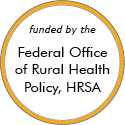Rural Project Examples: Promising
A program evaluation of this approach showed positive results.
TUSM-MMC Program Longitudinal Integrated Clerkship

Updated/reviewed April 2024
- Need: To fill vacant medical positions in Maine's rural medical facilities.
- Intervention: The Tufts Maine Track LIC program offers clerkships in rural medical facilities, exposing medical school students to the positives and possibilities that rural practices have to offer.
- Results: The program has seen an increase in students' interest in practicing in rural Maine. The majority of participants have pursued medical careers in one of the six core specialties studied during their clerkship.
Northeast Louisiana Regional Pre-Diabetes Prevention Program

Updated/reviewed March 2024
- Need: To prevent or slow the progression of diabetes for at-risk residents in Rural Northeast Louisiana.
- Intervention: The North Louisiana Regional Alliance developed a program that offered screenings, education, and an intense course for participants throughout the Northeast Louisiana region to lower the risk of diabetes.
- Results: The program saw an overall decrease in blood sugar levels in residents who participated in their initiatives.
SASH® (Support and Services at Home)
Updated/reviewed March 2024
- Need: In Vermont, the growing population of older adults, coupled with a lack of a decentralized, home-based system of care management, poses significant challenges for those who want to remain living independently at home.
- Intervention: SASH® (Support and Services at Home), based in affordable housing and their surrounding communities throughout the state, works with community partners to help older adults and people with disabilities receive the care they need so they can continue living safely at home.
- Results: Compared to their non-SASH peers, SASH participants have been documented to have better health outcomes, including fewer falls, lower rates of hospitalizations, fewer emergency room visits, and lower Medicare and Medicaid expenditures.
TelePrEP
Updated/reviewed March 2024
- Need: To prevent new cases of HIV in rural Iowa.
- Intervention: TelePrEP provides preventive care via telehealth and prescription delivery.
- Results: Between February 2017 and August 2020, TelePrEP received 456 referrals, with 403 patients completing an initial visit.
Health without Borders


Updated/reviewed January 2024
- Need: To improve the health of communities in the south central region of New Mexico.
- Intervention: A program was developed to specifically address diabetes prevention and control, behavioral healthcare, and immunization in Luna County.
- Results: During the program, 1,500 immunizations were distributed, baseline measurements of participants improved, and 935 new patients were seen for behavioral health issues.
Successfully Training and Educating Pre-medical Students (STEPS)
Updated/reviewed January 2024
- Need: To increase the number of primary care providers in northeast Kentucky.
- Intervention: STEPS provides support such as physician shadowing, mock interviews, and MCAT practice courses/exams for regional students applying to medical school.
- Results: More than 70% of participants have been accepted into medical school. The program has been replicated among most of Kentucky's regional AHECs.
Tomah Hearing Loss Prevention Outreach
Updated/reviewed November 2023
- Need: Farmers are highly susceptible to permanent hearing loss due to prolonged exposure to loud machinery and livestock.
- Intervention: Faculty and students from the audiology department at the University of Wisconsin-Madison supplied earplugs, free hearing testing, and hearing loss prevention education to attendees and participants at an annual tractor pull event.
- Results: Between 2014 and 2019, the audiology team distributed more than 16,000 pairs of earplugs; attendees were receptive to the hearing loss prevention education provided by the team.
Project C.A.R.E.
Updated/reviewed October 2023
- Need: There is a lack of dementia-specific support for rural caregivers.
- Intervention: Project C.A.R.E. was created to meet the needs of underserved caregivers of those with Alzheimer's or other dementias, targeting rural North Carolina.
- Results: Under Project C.A.R.E., rural families receive information and referrals as well as individualized care consultation from dementia-trained family consultants.
Texas C-STEP Project: Cancer Screening, Training, Education and Prevention Program
Updated/reviewed September 2023
- Need: Improve screening rates for rural uninsured/underinsured patients in counties surrounding Bryan-College Station, Texas.
- Intervention: An academic center's nursing and family medicine training programs partnered with its public health program to obtain state grant funds for execution of a coordinated cancer prevention and detection program.
- Results: In 5 years of colorectal screening efforts, 18 cases of colorectal cancer were diagnosed in addition to detection of precancerous lesions in 25% of nearly 2000 screening colonoscopies. In 3 years of women's health screening, 18 cases of breast cancer and 141 precancerous cervical lesions were also detected. Due to the initial success of the project, the program continues.
Faith, Activity, and Nutrition
Updated/reviewed August 2023
- Need: To increase healthy eating and physical activity levels in Fairfield County, South Carolina.
- Intervention: Community health advisors trained church committees and delivered telephone-based technical assistance to improve opportunities, guidelines, messages, and pastor support for physical activity and healthy eating.
- Results: In a 2018 study, churchgoers reported seeing more opportunities for physical activity as well as more messages and pastor support for physical activity and healthy eating. Intervention churches also had fewer inactive churchgoers, compared to control churches.
